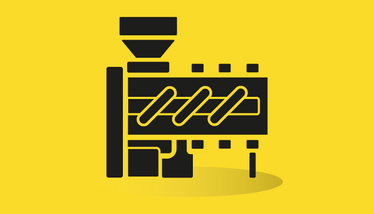Dosage Form Innovation with Hot Melt Extrusion
What’s going on with hot melt extrusion (HME)? We look at three recent studies that demonstrate the versatility of this manufacturing process for developing patient-centric dosage forms – from pediatric medicines to drug-loaded yarns.
| 3 min read | Technology

Child-Friendly Tinidazole Tablets
Researchers in India used 3D printing and HME to create more child-friendly tinidazole (TNZ) tablets. TNZ is commonly used to treat several infections, such as giardiasis, but it suffers from poor solubility and a bitter taste – the latter of which can lead children to refuse the medicine.
The researchers set out to create tablets that could be customized for precise dosing tailored to a child’s age, weight, and specific medical needs, selecting 3D printing as the most appropriate manufacturing approach. However, 3D printing requires that raw materials be evenly mixed and formed into a filament with the right mechanical qualities. To this end, HME was used to create amorphous solid dispersions of TNZ mixed with a polymer Kollidon25 (a soluble grade of polyvinylpyrrolidone). The polymer was selected for its ability to improve solubility and because tests confirmed good compatibility with TNZ.
With filaments in hand, the team used 3D printing to print dosage forms with different geometries that might appeal to pediatric patients. The tablets had a layer-by-layer pattern that helped improve the dissolution profile, with the tablets achieving 100 percent drug release within two hours in an acidic gastric medium. Finally, the bitter taste was also masked because TNZ was embedded within the polymer matrix, preventing direct contact with taste buds.
High-Shear Melt Versus HME
High-shear (HS) melt granulation and HME were compared for the production of amorphous solid dispersions of carvedilol, a drug with poor water solubility that is used to treat cardiovascular conditions. The study, conducted by a team from the University of Ljubljana, University of Bologna, and the Research Centre for Pharmaceutical Engineering in Austria, aimed to improve carvedilol’s dissolution using mesoporous carriers and polymer matrices. The research compared how well the two methods enhanced the drug's solubility and bioavailability.
Two mesoporous carriers, Syloid 244FP and Neusilin US2, were used to load the carvedilol-polymer mixtures. For the polymer matrix, either polyethylene glycol (PEG) 6000 or Soluplus were used, depending on the method.
One significant observation from the study was the difference in drug release profiles between the two methods. Syloid 244FP-based granules produced with HS melt granulation exhibited faster drug release than HME formulations. The researchers attributed this to the larger specific surface area and more porous structure of the HS granules, which allowed for faster interaction with the dissolution media. In contrast, HME extrudates had smoother surfaces and larger particle sizes, leading to slower but more controlled drug release.
The choice of polymer played a critical role in the performance of each formulation. PEG 6000 performed better than Soluplus in both technologies. Specifically, PEG 6000-based formulations, especially those made with HME, showed faster and more complete carvedilol release.
Despite the differences in drug release rates, both melt technologies offered advantages. HME was found to be more efficient and scalable, providing smoother particles with better flow properties, which could be beneficial for large-scale manufacturing. HS melt granulation, on the other hand, was superior in terms of rapid drug release, particularly for formulations using Syloid 244FP. The porous structure of the HS granules resulted in faster dissolution rates, which could be advantageous for drugs requiring immediate release.
Ultimately, the choice between the two technologies should be based on the specific needs of the formulation, such as desired release rate, scalability, and processing efficiency.
Knitting Drugs
Here’s a more unusual type of dosage form: drug-loaded multifilament yarns.
Created by HME, these yarns can then be processed into various shapes using a modified knitting machine, such as tubular structures or woven textiles, to deliver drugs in a controlled manner. Their large surface area and flexibility make them suitable for applications such as wound healing, implantable devices, or oral drug delivery systems.
In the study below, researchers optimized the process with scalability in mind, successfully producing fibers containing polyvinyl alcohol and a model drug, fluorescein sodium, through a continuous melt extrusion process. The resulting fibers were smooth, uniform, and demonstrated consistent tensile strength, making them suitable for pharmaceutical applications.



















